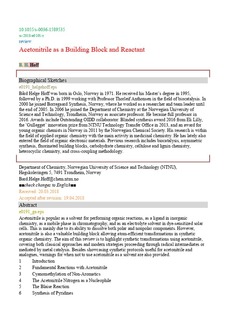| dc.contributor.author | Hoff, Bård Helge | |
| dc.date.accessioned | 2019-05-29T09:10:56Z | |
| dc.date.available | 2019-05-29T09:10:56Z | |
| dc.date.created | 2018-12-19T12:29:50Z | |
| dc.date.issued | 2018 | |
| dc.identifier.citation | Synthesis (Stuttgart). 2018, 50 (15), 2824-2852. | nb_NO |
| dc.identifier.issn | 0039-7881 | |
| dc.identifier.uri | http://hdl.handle.net/11250/2599396 | |
| dc.description.abstract | Acetonitrile is popular as a solvent for performing organic reactions, as a ligand in inorganic chemistry, as a mobile phase in chromatography, and as an electrolyte solvent in dye-sensitized solar cells. This is mainly due to its ability to dissolve both polar and nonpolar components. However, acetonitrile is also a valuable building block allowing atom-efficient transformations in synthetic organic chemistry. The aim of this review is to highlight synthetic transformations using acetonitrile, covering both classical approaches and modern strategies proceeding through radical intermediates or mediated by metal catalysis. Besides showcasing synthetic protocols useful for acetonitrile and analogues, warnings for when not to use acetonitrile as a solvent are also provided. | nb_NO |
| dc.language.iso | eng | nb_NO |
| dc.publisher | Thieme Publishing | nb_NO |
| dc.title | Acetonitrile as a Building Block and Reactant | nb_NO |
| dc.type | Journal article | nb_NO |
| dc.type | Peer reviewed | nb_NO |
| dc.description.version | acceptedVersion | nb_NO |
| dc.source.pagenumber | 2824-2852 | nb_NO |
| dc.source.volume | 50 | nb_NO |
| dc.source.journal | Synthesis (Stuttgart) | nb_NO |
| dc.source.issue | 15 | nb_NO |
| dc.identifier.doi | 10.1055/s-0036-1589535 | |
| dc.identifier.cristin | 1645566 | |
| dc.description.localcode | © Thieme Publishing Group 2018. This is the authors accepted and refereed manuscript to the article. Locked until 13.6.2019 due to copyright restrictions. Available at http://dx.doi.org/10.1055/s-0036-1589535 | nb_NO |
| cristin.unitcode | 194,66,25,0 | |
| cristin.unitname | Institutt for kjemi | |
| cristin.ispublished | true | |
| cristin.fulltext | preprint | |
| cristin.qualitycode | 1 | |
